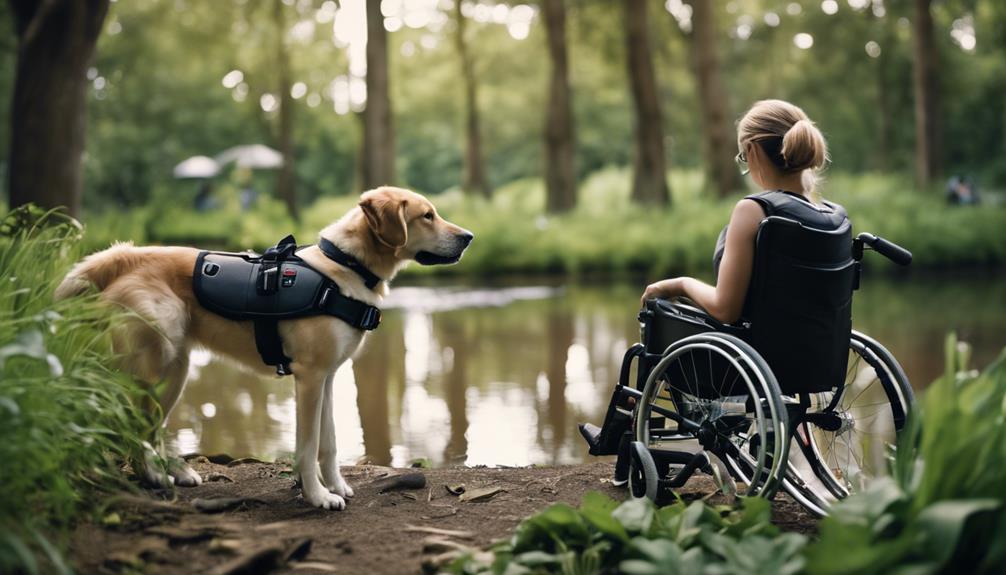Best Service Dog Training Books to Read
- Advertisement -
You're about to venture on a pivotal journey of training a service dog, and with the right resources, you can set your dog up for success. Top recommended training books include "The Magic of Training a Service Dog" focusing on PTSD service dogs, "Service Dog Training Guide" offering a structured program, and "The Ultimate Service Dog Training Manual" covering 100 tips and techniques. For therapy dog training, "Therapy Dogs – Training Your Dog To Reach Others" provides valuable guidance. Specialized training resources are also available, such as "Lend Me An Ear" for hearing ear dogs and "The Super Sniffer Handbook" for scent training. As you explore these resources, you'll discover the keys to developing a strong bond with your service dog and tapping into their full potential.
Key Takeaways
- "The Magic of Training a Service Dog: A Trainer's Guide" provides a detailed training program for PTSD service dogs.
- "Service Dog Training Guide: A Step-by-Step Training Program for You and Your Dog" covers essential skills and tasks for service dogs.
- "Selecting And Training Your Service Dog: How to Succeed in Public Access Work" is a valuable resource for public access work and task-oriented training.
- "The Ultimate Service Dog Training Manual: 100 Tips for Choosing, Raising, Socializing, and Retiring Your Dog" covers all aspects of service dog training.
- "Lend Me An Ear: Temperament, Selection and Training Of The Hearing Ear Dog" offers expert guidance on temperament, selection, and training for hearing ear dogs.
Service Dog Training Essentials
A service dog's effectiveness relies on its ability to perform specific tasks that assist individuals with disabilities or conditions. To achieve this, you'll need to focus on essential skills and tasks through extensive training.
A step-by-step training program can help you achieve this goal. These programs typically cover obedience, agility, and task training, ensuring your dog is well-equipped to handle various scenarios. Socialization and desensitization are critical components of service dog training. Your dog needs to be comfortable in diverse environments and situations to provide effective assistance.
When training for PTSD service dogs, a patient and positive approach is crucial. Your dog needs to understand its handler's needs deeply. To aid in your training, utilize resources such as manuals and sound CDs specifically designed for socialization and desensitization. These tools provide valuable guidance and support, helping you create a well-rounded and capable service dog.
Investing time and effort into service dog training will reward you with a loyal companion that can greatly enhance the life of an individual in need.
Therapy Dog Training Guides
Therapy dog training guides provide valuable resources for training your dog to become a certified therapy dog. These guides offer step-by-step instructions and insights to help you navigate the training process.
For example, "Therapy Dogs – Training Your Dog To Reach Others, 2nd Edition" covers basic obedience to advanced task training. "A Dog Who's Always Welcome – Assistance and Therapy Dog Trainers Teach You How To Socialize and Train Your Companion Dog" provides practical advice on socialization, obedience, and task training.
If you're training a service dog, "Teamwork – A Dog Training Manual for People With Disabilities, Revised Edition" is a useful resource. This manual focuses on building a strong relationship between you and your dog, teaching basic obedience, and training for specific tasks. "Teamwork II – Dog Training Manual for People With Disabilities (SERVICE Exercises)" offers specialized exercises and training protocols for therapy dogs.
Additionally, "Ebook: Therapy Dogs Today – Their Gifts, Our Obligation – 2nd Edition" is a digital guide that explores the role of therapy dogs and provides practical advice for training and certifying therapy dogs.
These therapy dog training guides are essential resources to help you and your dog become a certified therapy dog team. They provide clear instructions and valuable insights to support your training journey.
Specialized Service Dog Training

When training a service dog, it's crucial to consider the individual's specific needs and the task at hand. Specialized service dog training requires a tailored approach to ensure the dog's skills align with the individual's requirements.
For hearing ear dog training, "Lend Me An Ear: Temperament, Selection and Training Of The Hearing Ear Dog" provides valuable insights into temperament, selection, and training. This resource helps you train a dog that meets the individual's needs.
For scent training for medical alert dogs, "The Super Sniffer Handbook: A Guide To Scent Training for Medical Alert Dogs" is an exhaustive guide. It covers basic obedience, scent work, and task training, providing a solid foundation for training.
People with disabilities may find "Teamwork II – Dog Training for People With Disabilities (SERVICE Exercises) DVD" and its companion DVD, "Teamwork – for People With Disabilities DVD", to be valuable resources. These DVDs offer video instructions and exercises for training service dogs, making it easier to select and train the right dog.
"Ebook: Animal Assisted Interventions – Professionals Embrace the Power of the Dog" explores the role of animals in assisting professionals in various settings, including therapy, education, and healthcare. This digital guide helps you understand the importance of service dogs in different contexts.
Top Recommended Resources
Top Recommended Resources for Service Dog Training
These expert guides and manuals provide comprehensive information on service dog training, covering essential skills, tasks, and best practices. They cater to both experienced trainers and beginners, offering a range of knowledge and skills necessary for training a well-behaved and effective service dog.
- The Magic of Training a Service Dog: A Trainers Guide with an emphasis on PTSD Service Dogs: This guide focuses on training service dogs for individuals with post-traumatic stress disorder (PTSD).
- Service Dog Training Guide: A Step-by-Step Training Program for You and Your Dog: This resource offers a structured training program, covering essential skills and tasks for service dogs.
- Selecting And Training Your Service Dog: How to Succeed in Public Access Work: This book emphasizes the selection and training of service dogs, with a focus on public access work and task-oriented training.
- The Ultimate Service Dog Training Manual: 100 Tips for Choosing, Raising, Socializing, and Retiring Your Dog: This manual provides 100 tips and techniques for training service dogs, covering various aspects of their development and care.
- Therapy Dogs – Training Your Dog To Reach Others, 2nd Edition: This highly rated book specializes in therapy dog training, offering guidance on selecting, training, and certifying therapy dogs.
These resources provide a solid foundation in service dog training, covering topics such as training guides, online dog training, and best service dog training practices. By utilizing these expert guides and manuals, you'll be well-equipped to develop a highly skilled and effective service dog.
- Advertisement -
Expert-Approved Training Manuals

Training a service dog requires expertise and precision. To ensure success, you need a comprehensive training manual that addresses your dog's unique needs.
For PTSD service dogs, "The Magic of Training a Service Dog: A Trainer's Guide" provides a detailed training program. If you prefer a structured approach, "Service Dog Training Guide: A Step-by-Step Training Program for You and Your Dog" covers essential skills and tasks.
For public access work, "Selecting And Training Your Service Dog: How to Succeed in Public Access Work" is a valuable resource. "The Ultimate Service Dog Training Manual: 100 Tips for Choosing, Raising, Socializing, and Retiring Your Dog" covers all aspects of service dog training, from choosing a puppy to retiring a working dog.
If you're training a hearing ear dog, "Lend Me An Ear: Temperament, Selection and Training Of The Hearing Ear Dog" offers expert guidance on temperament, selection, and training.
These expert-approved training manuals provide a tailored approach to training, ensuring you're equipped to meet your service dog's unique needs. By investing in one of these resources, you'll be well on your way to raising a highly trained and capable service dog.
Frequently Asked Questions
What Is the Highest Rated Dog Training Certification?
The Certified Professional Dog Trainer (CPDT) certification is the highest rated in the industry. To earn it, you must complete a rigorous certification process that meets strict training standards and accreditation requirements. This certification demonstrates expertise, professional credentials, and industry recognition. It also shows compliance with regulatory requirements.
The CPDT certification is based on humane, science-based training methods. This approach earns respect from peers and clients. To achieve certification, you must meet the requirements set by the Certification Council for Professional Dog Trainers (CCPDT).
The CCPDT ensures that certified trainers have the necessary knowledge, skills, and experience to train dogs effectively and humanely. The certification process includes a written exam, experience requirements, and ongoing education. This ensures that certified trainers stay up-to-date with the latest research and best practices.
How Many Commands Must a Dog Learn to Be a Service Dog?
To become a service dog, a dog must learn at least 30 commands. These commands should include basic obedience skills like "sit" and "stay," as well as tasks specific to the handler's disability. Socialization skills are also essential.
The specific commands a dog needs to learn will depend on the handler's needs. For example, a dog assisting someone with mobility issues may need to learn to open doors or pick up items. A dog assisting someone with a seizure disorder may need to learn to alert others or provide physical support.
In addition to learning commands, a service dog must also be well-behaved in public and able to focus on their handler in distracting environments. This requires extensive training and socialization.
What Is the Number One Rule in Dog Training?
The number one rule in dog training is positive reinforcement. This approach focuses on rewarding desired behaviors rather than punishing undesired ones. A consistent routine and clear communication are crucial. Set up a reward system that motivates your dog, and use gentle correction when necessary.
A patient handler is essential, as dogs respond to calm and confident energy. Establish a daily routine that includes training sessions, breaks, and playtime. This structure helps your dog understand what's expected of them.
When correcting your dog, avoid punishment or negative reinforcement. Instead, gently redirect them towards the desired behavior. Consistency and patience are key to successful dog training. By following these principles, you'll build a strong bond with your dog and help them become a well-trained service animal.
What Is the Best Method of Dog Obedience Training?
When selecting a dog obedience training method, opt for Positive Reinforcement, Reward Training, or Clicker Training. These approaches are based on scientific research, gentle, and force-free. They prioritize socialization and building trust with your puppy.
By rewarding desired behaviors, you'll strengthen your bond with your dog and promote good habits. Avoid methods that use punishment or aversion, as they can harm your relationship and your dog's well-being. Instead, choose evidence-based methods that focus on your dog's well-being and your relationship.
These methods work by associating desired behaviors with rewards, such as treats or praise. This encourages your dog to repeat the behavior, allowing you to build on it. As you progress, you can phase out rewards and use life rewards, like play or affection, to maintain good habits.
In summary
When training your service dog, understanding the best techniques and strategies is crucial. Reading the right books provides essential knowledge to help you develop a strong partnership with your dog. The training manuals and guides mentioned above offer expert-approved advice on how to raise a well-behaved and highly skilled service dog. By following their guidance, you'll be better equipped to help your dog reach its full potential and become a trusted companion.
- Advertisement -

